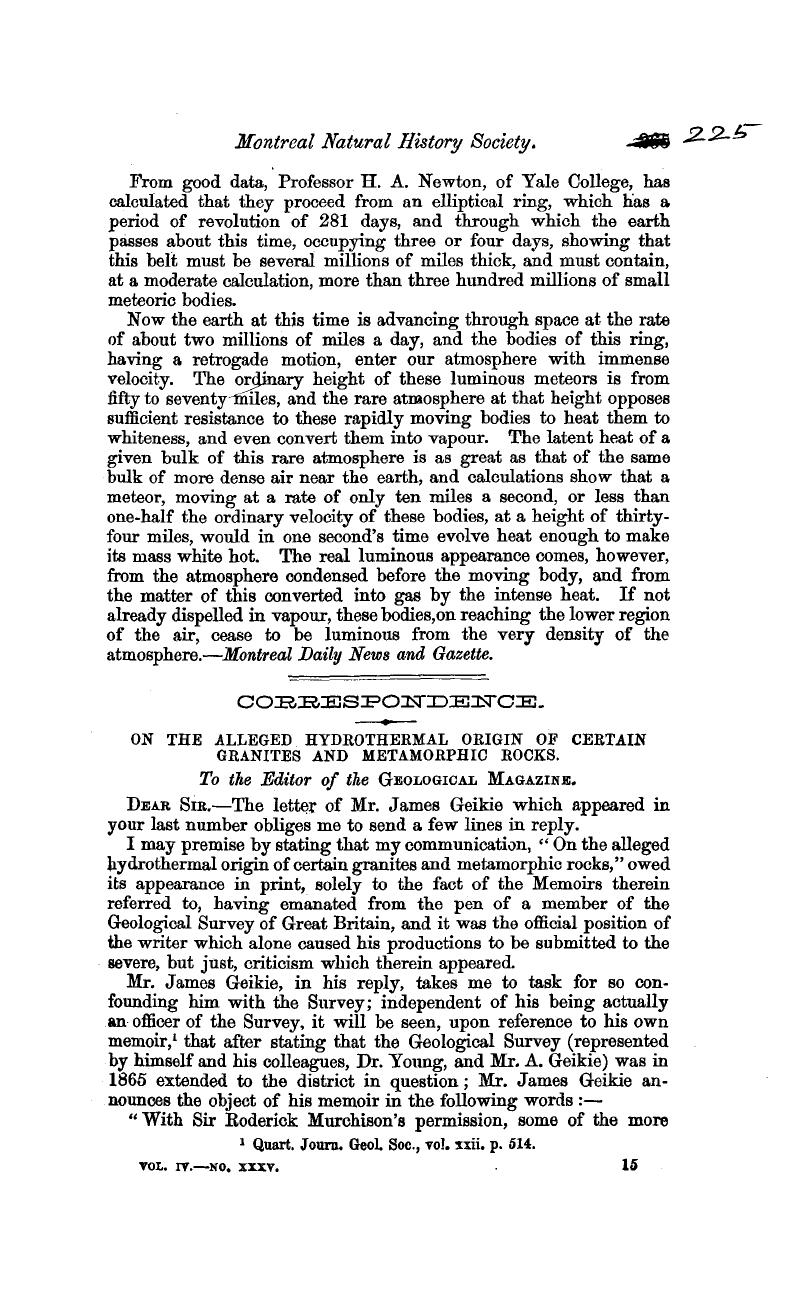No CrossRef data available.
Article contents
On the Alleged Hydrothermal Origin of Certain Granites and Metamorphic Rocks
Published online by Cambridge University Press: 01 May 2009
Abstract

- Type
- Correspondence
- Information
- Copyright
- Copyright © Cambridge University Press 1867
References
page 225 note 1 Quart. Journ. Geol. Soc., vol. xxii. p. 514.Google Scholar
page 227 note 1 Vide Reviews in Geological Magazine and Atheneum.
page 227 note 2 There is no want of special works on this subject; to witness the publications of Blum, Brongniart, Coquand, D'Halloy, Erdman, Leonhardt, Mayer, Macculloch, Pinkerton, Both, Seuft, Serres, Zirkel, etc.
page 228 note 1 Amongst others, I can refer to the highly crystalline Hornblende rocks so extensively occurring on the whole of the south coast of Norway, examined by me in 1853 and following year, and which it will be seen in my “Geologiske Undersogelse over det metamorphiske Territorium, ved Norges Sydkyst.” Nyt Magazin for Naturvidenskaberne, Vol. iv. p. 164 et seq., I have declared to be, in my opinion, all formed in titû from tuffs of aqueous deposition.
page 228 note 2 Nyt Magazin for Naturndenskaberne, Vol. i., 1838, and more fully in the Gaea Norwegica, Vol. i., of same author.
page 228 note 3 Quart. Journ. Geol. Soc., Vol. i. p. 467.Google Scholar
page 228 note 4 Das Christiania Silurbecken chemisch geognostish untersucht, 1855.
page 229 note 1 Since my former communication, the arrival of Dr. Sterry Hunt in this country has procured me the pleasure of his personal acquaintance. The opportunity thus afforded us, of comparing notes on chemical geology, showed how many similar conclusions we had respectively come to, from the study of widely different parts of the globe, and assured us that any difference in opinion could not arise as to the agencies employed in Nature's operations, although we might lie somewhat at variance as to the precise extent to which each agent had been engaged.
page 229 note 2 A study of the rock in the field in localities specially characteristic, combined with an examination of the descriptions given by the numerous writers on the subject, has resulted in my defining this rock species as follows:—
Greywacké—A sedimentary rock usually of a greyish colour (whence its name) found extensively developed in the earlier geological formations; but not specially characteristic of anyone of same. Petrologically, “greywacké” is an impure sandstone, more or less argillaceous, formed from the débris of previously existing rocks, rearranged by aqueous action, and subsequently, more or less consolidated. Usually compact, it may vary in texture from fine-grained to coarsely conglomeritic; the stratification of the beds is frequently indistinct, unless viewed upon the large scale; when coarse it may contain fragments of fossils, and of other rocks, as clay-slate, mica schist, granite, porphyry, limestone, etc. Mineralogically, it is essentially quartz, with more or less clay, and frequently contains grains or scales of mica, chlorite, talc, lithomorge felspar, calcite, iron pyrites, etc. Chemically, it is composed of some seventy to eighty-five per cent, silica, along with alumina and a little oxide of iron, with but traces of the alkali and alkaline earths. Chemical and microscopical examination show comparatively little combined silica, the major part being in the free state as quartz.
This definition I maintain is in accordance with the views of all the writers on the subject whom I have consulted, and in corroboration thereof, I would cite the following references: Bischoff, iii. p. 132; Blum, p. 284; Brongniart, pp. 123, 126; Coquand, p. 238; Cotta, p. 301; D'Halloy, p. 15; Erdman, p. 173; Grimm, p. 215; Jameson, p. 226; Kjeruff, p. 72; Leonhardt, p. 171; Mayer, iii. p. 1; Maccnlloch, p. 358; Page, p. 309; Pinkerton, i. p. 291; Phillips, p. 654; Eoth, p. 69; Senft, p. 332; Zirkel, ii. p. 694.
page 229 note 3 And our little Island is probably one of the best localities in Europe for the study of this rock.




